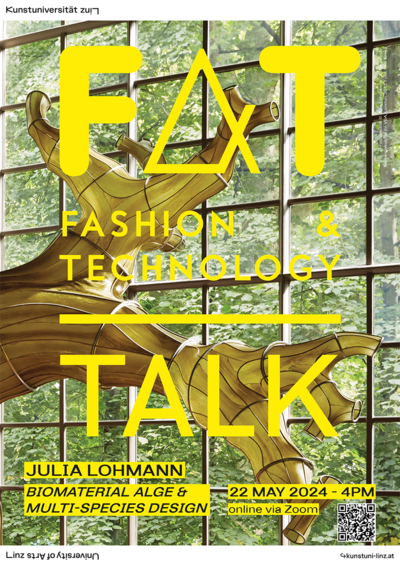Welcome at the Interface Culture program website.
Acting as creative artists and researchers, students learn how to advance the state of the art of current interface technologies and applications. Through interdisciplinary research and team work, they also develop new aspects of interface design including its cultural and social applications. The themes elaborated under the Master's programme in relation to interactive technologies include Interactive Environments, Interactive Art, Ubiquitous Computing, game design, VR and MR environments, Sound Art, Media Art, Web-Art, Software Art, HCI research and interaction design.

The Interface Culture program at the Linz University of Arts Department of Media was founded in 2004 by Christa Sommerer and Laurent Mignonneau. The program teaches students of human-machine interaction to develop innovative interfaces that harness new interface technologies at the confluence of art, research, application and design, and to investigate the cultural and social possibilities of implementing them.
The term "interface" is omnipresent nowadays. Basically, it describes an intersection or linkage between different computer systems that makes use of hardware components and software programs to enable the exchange and transmission of digital information via communications protocols.
However, an interface also describes the hook-up between human and machine, whereby the human qua user undertakes interaction as a means of operating and influencing the software and hardware components of a digital system. An interface thus enables human beings to communicate with digital technologies as well as to generate, receive and exchange data. Examples of interfaces in very widespread use are the mouse-keyboard interface and graphical user interfaces (i.e. desktop metaphors). In recent years, though, we have witnessed rapid developments in the direction of more intuitive and more seamless interface designs; the fields of research that have emerged include ubiquitous computing, intelligent environments, tangible user interfaces, auditory interfaces, VR-based and MR-based interaction, multi-modal interaction (camera-based interaction, voice-driven interaction, gesture-based interaction), robotic interfaces, natural interfaces and artistic and metaphoric interfaces.
Artists in the field of interactive art have been conducting research on human-machine interaction for a number of years now. By means of artistic, intuitive, conceptual, social and critical forms of interaction design, they have shown how digital processes can become essential elements of the artistic process.
Ars Electronica and in particular the Prix Ars Electronica's Interactive Art category launched in 1991 has had a powerful impact on this dialog and played an active role in promoting ongoing development in this field of research.
The Interface Cultures program is based upon this know-how. It is an artistic-scientific course of study to give budding media artists and media theoreticians solid training in creative and innovative interface design. Artistic design in these areas includes interactive art, netart, software art, robotic art, soundart, noiseart, games & storytelling and mobile art, as well as new hybrid fields like genetic art, bioart, spaceart and nanoart.
It is precisely this combination of technical know-how, interdisciplinary research and a creative artistic-scientific approach to a task that makes it possible to develop new, creative interfaces that engender progressive and innovative artistic-creative applications for media art, media design, media research and communication.
Biomaterial Alge & Multi-Species Design
22. Mai 2024, 16.00 Uhr ONLINE via Zoom
Fashion & Technology lädt zum Talk mit Julia Lohmann
online via Zoom: us06web.zoom.us
Meeting-ID: 883 9263 8870
Kenncode: sw3f6t
The talk will be held in English!
Julia Lohmann sondiert durch ihre Arbeit mit Algen, sowie Flora- und Fauna-basierten Biomaterialien unsere Wertesysteme und unser Verhältnis zur Natur. Seit 2013 widmet sie sich mit dem Kollektiv Department of Seaweed der Entwicklung von Seetang als nachhaltiges, ökosystemisch regeneratives Designmaterial. Im Meer dient Seetang einer Vielzahl von Lebewesen als Brutstätte und Biotop und spendet Schutz und Nahrung. Als Biomaterial dient es als Vorbild für eine empathischere Materialnutzung, die nicht auf Kosten anderer Organismen stattfindet. Julia Lohmann beschreibt anhand von Projektbeispielen ihren Multi-Species-Mindset und ihre Entwicklung regenerativer Design- und Materialforschungs-Praktiken.
Die Designerin und Künstlerin Julia Lohmann erforscht und hinterfragt die ethischen und materialbezogenen Wertesysteme, die die Beziehung zwischen Menschen und der Natur beeinflussen. Lohmann ist Professorin für Contemporary Design an der Aalto University in Finnland. Hier vermittelt sie einen öko-sozialen,regenerativen Designansatz. Sie studierte und unterrichtete am Londoner Royal College of Art (RCA) wo sie 2018 mit einem praxisbasierten PhD und einem Arbeitsaufenthalt am Victoria & Albert Museums (V&A) promovierte. 2013 gründete Julia Lohmann das Department of Seaweed, ein transdisziplinäres Kollektiv aus Künstler*innen, Designern*innen, Wissenschaftler*innen und Meeresschützer*innen, das sich der Entwicklung von Algen als nachhaltigem Biomaterial widmet und sich für den Schutz der Meere einsetzt. Julia Lohmanns vielfach ausgezeichnete Arbeiten sind Teil öffentlicher und privater Sammlungen weltweit.
